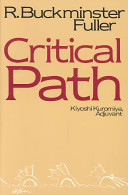Geometry Divides the World
This meant, then, that the Greeks, in attempting to communicate their mathematical conceptioning, defined the circle as "an area bound by a closed line of equal radius from one point," the triangle as "an area bo)ound by a closed line of three angles, three edges, and three vertices." The Greeks talked only of the area that was "bound" as having validity and identity, while outside (on the other side of the boundary) existed only treachenerous terrain leading outward to boundless infinity—an unknown and unknowable wilderness. The feedback from this worid view has ingrained fundamental biases into our present-day thinking. We can conceive only of (' one side of a line as definable, organized, and valid. "Our side" is natural z and right—"God's country"—and vice versa. All humanity has thought of its own local area as being familiar, organized, and a priori, with all else remote and unthinkable. The Greeks oversimplified conceptioning with their mis assumption that geometry could begin with plane geometry which they said employed only three tools: the straightedge, the scribe, and dividers. They failed altogether to include the surface on which they scribed as constituting an equally essential component of their otherwise experimentally demonstrated proofs of their various propositions. Because the earth of the Earth on which they scribed was so large and its limits were unknown to them, they concluded that it was an infinitely extended surface. They failed altogether to recognize the fact that you cannot have a surface of nothing. Any surface on which they scribed had to be a topological feature of a system. They obviously knew naught of Euler's topology nor of my systems geometry (see Chapter 4, Synergetics, vol. 1). Systems always divide all Universe outside the system from all of the Universe inside the system. All systems are finite subdividers of macro- and micro-Universe. Not knowing that ththey were always scribing on a closed, finite system, the Greeks defined a plane geometrical polygon as "an area bound by a closed line of so many angles and edges." They assumed that the area on the "outer" side of the line continned laterally to infinity and was therefore undefinable. What their closed lines always did was to divide all the finite surface area of the polyhedronal system on which they scribed into two finite areas both of which were exactly bound by the surface-drawn polygon's perimeter. Draw a triangle on the sand of a beach. You inadvertently divide all the surface of planet Earth into two areas, A and B—"A" the triangle which you consciously and visually drew and "B" the enormous area on the "outside" of the consciously drawn triangle, consisting of all the rest of the surface of our spherical planet Earth. All that remaining surface of our spherical-surface Earth is bound by the closed-perimeter figure of "three angles and three edges" which you scribed in the sand. Unbeknownst to them, the Greek Euclideans were al¬ ways dealing in polyhedra of "system geometry." Humans could not make a local Earth-surface triangle without inherently making a vast terrestrialsize triangle. The two terrestrial triangles, little A and vast B, in turn brought inherently into play the almost spherical, vastly high-frequency-triangulated polyhedronal system on whose surface they were scribing. This in tum and unbeknownst to them affected the rest of the Universe—the macro-Universe outside the system upon which they scribed and the microUniverse inside the system upon which they scribed. Thus humans have always unknowingly affected all Universe by every act and thought they articulate or even consider.
Notes:
By describing shapes as bounded, the Greeks reflected (or influence?) our thoughts about our own boundaries.
Folksonomies: culture mathematics perception
Taxonomies:
/science/mathematics/geometry (0.650528)
/art and entertainment/visual art and design/design (0.433124)
/business and industrial (0.169226)
Keywords:
closed line (0.932320 (negative:-0.294087)), consciously drawn triangle (0.733661 (neutral:0.000000)), experimentally demonstrated proofs (0.728158 (positive:0.407812)), infinitely extended surface (0.722350 (neutral:0.000000)), equally essential component (0.715352 (positive:0.407812)), finite surface area (0.709821 (neutral:0.000000)), vast terrestrialsize triangle (0.707693 (neutral:0.000000)), local Earth-surface triangle (0.703762 (neutral:0.000000)), plane geometrical polygon (0.700414 (neutral:0.000000)), spherical planet Earth (0.670223 (neutral:0.000000)), Greeks (0.646052 (negative:-0.294643)), area bo (0.559707 (negative:-0.516357)), boundless infinity—an (0.559400 (positive:0.202169)), unknowable wilderness (0.556888 (positive:0.202169)), equal radius (0.554405 (neutral:0.000000)), treachenerous terrain (0.548482 (positive:0.202169)), mathematical conceptioning (0.547930 (neutral:0.000000)), fundamental biases (0.544368 (positive:0.844859)), finite subdividers (0.540104 (negative:-0.203125)), worid view (0.538889 (positive:0.844859)), present-day thinking (0.536821 (positive:0.844859)), mis assumption (0.534064 (negative:-0.367922)), topological feature (0.533390 (neutral:0.000000)), various propositions (0.533260 (positive:0.407812)), local area (0.530960 (neutral:0.000000)), plane geometry (0.520675 (negative:-0.367922)), surface-drawn polygon (0.520544 (neutral:0.000000)), finite areas (0.518662 (neutral:0.000000)), terrestrial triangles (0.515225 (neutral:0.000000)), enormous area (0.515161 (neutral:0.000000))
Entities:
Synergetics:Person (0.682827 (neutral:0.000000))
Concepts:
Universe (0.954258): dbpedia | freebase
Earth (0.825236): dbpedia | freebase
Geometry (0.793512): dbpedia | freebase | opencyc
Topology (0.773611): dbpedia | freebase | opencyc
Polygon (0.605372): dbpedia | freebase | opencyc
Analytic geometry (0.578892): dbpedia | freebase
Planet (0.556709): dbpedia | freebase | opencyc
Heron's formula (0.546754): dbpedia | freebase | yago





